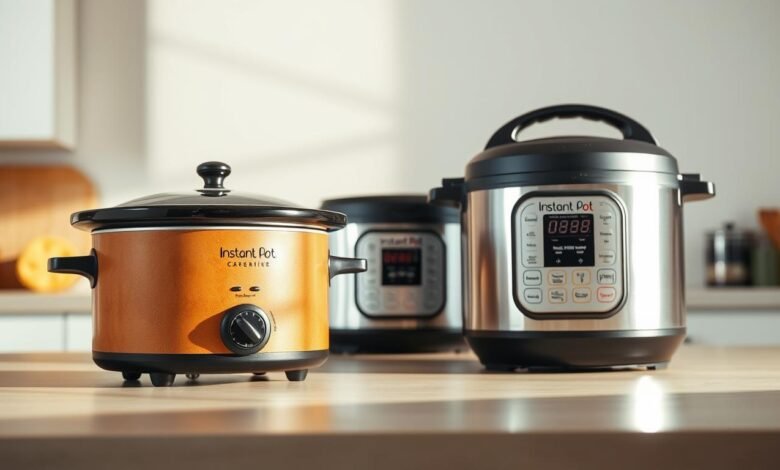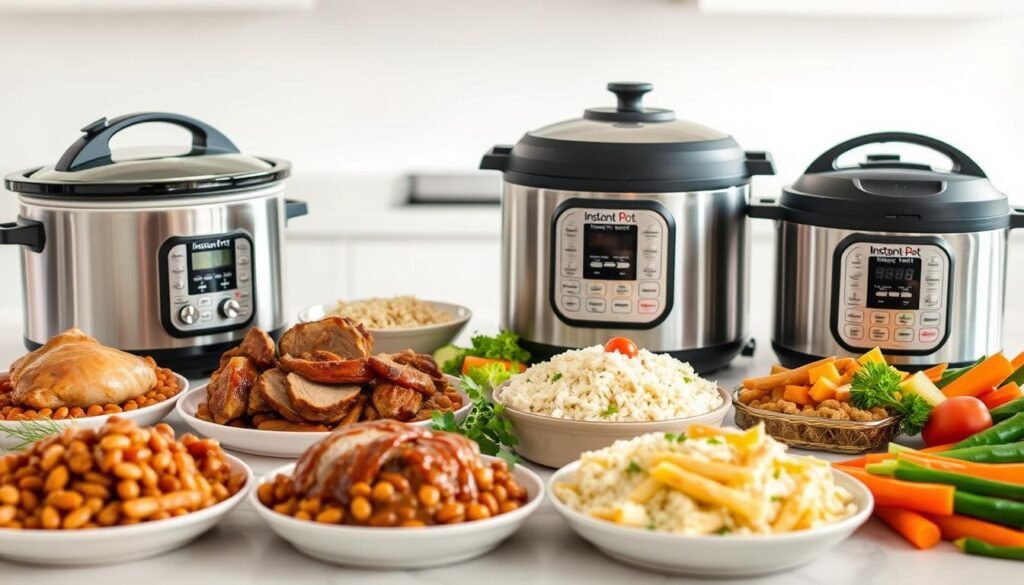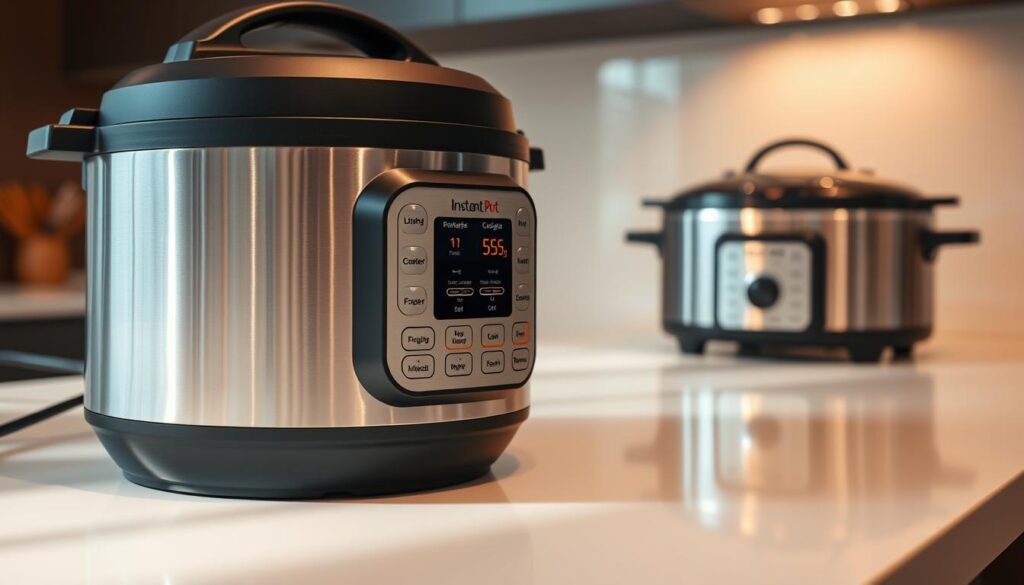
You probably remember a meal that felt like a warm hug — the kind that comes from slow-simmered stews or a quick weeknight roast that falls apart with a fork. Choosing an appliance for your kitchen can feel personal because it shapes how you feed your family and how much time you spend cooking.
On one side, a traditional slow cooker offers set-and-forget ease. It brings long-simmered flavors with minimal babysitting. On the other, an Instant Pot is a branded multicooker built around pressure cooking. It shines when you need fast, tender results and versatility for rice, yogurt, and sautéing.
Think about what you make most. If you favor long weekend braises, a specialist cooker may suit you. If you juggle busy weeknights, a multicooker that handles pressure and multiple features can save time and dishes.
Key Takeaways
- One appliance excels at set-and-forget, slow-simmered meals; the other gives speed and versatility.
- Pressure functions deliver tender meat and creamy beans fast.
- Features like browning or sautéing cut down on extra pans.
- Choose based on the meals you cook, counter space, and how you like to plan.
- Brand and model matter—pick the features you will actually use.
At a glance: what you’re comparing and how it impacts your weeknight dinner
Your weeknight choices hinge on whether you want speed or slow flavor building. Pressure cooking ramps water to roughly 250°F at about 15 psi, which cooks food fast and forces moisture into ingredients. Low-and-steady heat breaks down collagen over hours and deepens sauce flavors.
Controls and shape matter for daily use. Simple dials (Low, High, Warm) make set-and-forget cooking easy. Multicookers offer many modes but need a short learning curve. Taller, narrow pots suit whole birds; wider, oval units fit ribs and layered meals better.
- Speed vs. depth: pressure gives quick tenderness; long heat makes richer melded flavors.
- Capacity: many multicookers stop near 8 quarts; some slow options reach 10 quarts for big batches.
- Liquid and pressure: sealed methods need precise water to build pressure; low-heat methods evaporate less.
- Daily payoff: fewer dishes with a multicooker once you learn modes; simpler appliance use for hands-off braises.
| Feature | Pressure-based appliance | Low-heat appliance |
|---|---|---|
| Typical max size | Up to 8 quarts | Up to 10 quarts |
| Cooking time | Fast (minutes to an hour) | Slow (hours) |
| Best for | Quick shredded meat, soups, fast beans | Braises, layered dishes, large roasts |
| Controls | Multiple modes; steeper learning curve | Simple settings: Low, High, Warm |
If you want a short primer comparing these approaches, see this quick comparison of common cookers. Decide by the foods you make, how much time you have, and the benefits you want from a single appliance.
Slow cooker vs instant pot: core differences in how they cook food
How an appliance applies heat and pressure shapes the result on your plate.
Cooking methods explained:
Low-and-steady moist heat in dedicated slow cookers breaks down collagen in beef and lamb over many hours. That process yields pull-apart meat and deeply melded sauces.
By contrast, a pressure cooker seals steam and raises water temperature to roughly 250°F at about 15 psi. This pressure cooking speeds the reaction that tenderizes meat and cooks beans, grains, and chicken far faster.
Flavor and texture outcomes
Slow cooking gives ultra-soft textures and richer melded flavors. Browning usually needs a separate sear, a slow cooker with a browning setting, or the sauté mode on a multicooker.
Pressure methods often keep vegetables firmer and can preserve more nutrients when timed correctly. Some instant pot models struggle with very large roasts; certain multicookers like the Cosori 6.0-Quart have handled slow modes better.
Time and energy factors
Pressure cooking is generally more energy-efficient and runs about 4–8 times faster overall. Remember that a full pot can take up to 30 minutes to reach pressure, which adds to total cook time.
Set-and-forget low-and-slow cooking trades speed for a hands-off day. Choose by the cuts and recipes you make most: quick weeknight meals often favor pressure, while weekend braises benefit from long heat and gentle evaporation.
| Aspect | Low-and-steady appliance | Sealed pressure appliance |
|---|---|---|
| Primary method | Gentle moist heat over hours | High-pressure steam at elevated temperature |
| Best results for | Large roasts, layered casseroles, lamb shoulder | Quick shredded meat, beans, rice, quick chicken |
| Browning | Limited unless model has sear feature | Built-in sauté mode or separate sear needed |
| Energy & time | Longer run time; low active energy draw | Faster cooking; more efficient but has heat-up phase |
Features and functions that matter on your counter
Your counter needs more than one flashy feature—it needs the right mix of functions you’ll actually use every week.
What many multicookers bring: Most instant pot models combine pressure cooking, a slow option, sauté, steam, rice cooking and a yogurt program. That combo lets you brown, deglaze, and switch to pressure in one pot, cutting dishes and locking flavors under a sealed lid.
What reliable low-heat pots do best
Slow cookers keep controls simple: Low, High, Warm. Some models now add a browning function so you can sear before the long cook without grabbing another pan.
Shape, size, and capacity
Taller pressure-based cookers fit whole birds and stack better for rice or pasta nights. Shorter, oval units suit ribs and flat roasts more naturally.
- Pick 6–8 quarts for most families; some slow cookers reach 10 quarts for gatherings.
- Choose a model with presets you’ll actually use; easy controls make consistent cooking simpler.
- If you lean on instant pot recipes that sauté then pressure, the mode switching saves time and cleanup.
| Feature | Multicooker | Low-heat pot |
|---|---|---|
| Common functions | Pressure, sauté, rice, yogurt | Low/High, Warm, some browning |
| Typical max size | Up to 8 quarts | Up to 10 quarts |
| Best for | Quick meals, rice, beans | Braises, large roasts |
Cooking results by dish: pot roast, chicken, beans, rice, pasta, and veggies
Different foods respond to heat and pressure in predictable ways, so choose the method that highlights the ingredient.

Meats and roasts: when low-and-slow shines and when pressure saves the day
For a pot roast or big lamb shoulder, a slow cooker often wins for shreddable, silky meat that develops deep jus over long time. A dedicated low-heat cooker builds flavor and texture for large, dense cuts.
If you forgot to plan, an instant pot can save the day. It tenderizes beef and chicken fast so you still get fork-tender results in far less time.
Grains, beans, and more: fluffy rice, creamy beans, quick pasta, and delicate vegetables
Pressure cooking excels for beans, rice, and steamed vegetables. You get creamy beans and fluffy rice with minimal fuss.
Pasta can remain pleasantly al dente when sealed correctly, while root vegetables do best with long, gentle heat. If a recipe needs brown fond, sear first using the sauté mode or a pan to deepen flavor.
| Dish | Best outcome | When to choose |
|---|---|---|
| Pot roast / large beef | Silky, shreddable meat | Use low-heat for depth; pressure if rushed |
| Chicken | Tender, quick results | Pressure for weeknights; low-heat for braised flavor |
| Beans & rice | Creamy beans; fluffy rice | Pressure for speed and consistency |
| Pasta & veggies | Al dente pasta; bright vegetables | Pressure for quick, sealed cooks; low-heat for long stews |
Ease of use, safety, and learning curve in real kitchens
Everyday cooking should feel manageable, not like a test. You’ll notice two clear paths: simple dials that let you set and forget, or multifunction models that ask for a bit of learning up front.
Start small. A slow cooker has an easy dial and low risk of scorching. An instant pot requires time to learn buttons, pressure levels, and timing for consistent meals.
Pressure release basics
Natural release means the unit cools and depressurizes itself, often 10–20 minutes. It is gentler and great for soups, braises, and large cuts.
Quick release vents steam fast. Use it for delicate vegetables or when you need dinner fast, but watch for splatter.
| Topic | When to use | Notes |
|---|---|---|
| Natural release | Soups, roasts, thick sauces | Gentler texture; adds 10–20 minutes |
| Quick release | Veggies, timed meals | Fast results; risk of hot steam and splatter |
| Sauté before sealing | Brown meat, reduce liquids | Reduces splatter and improves flavor |
| Full cold pot | Any recipe | Can add up to 30 minutes to reach pressure |
Modern pressure cooker models include locking lids, sensors, and auto valves to protect you at home. Over time you’ll learn to add a touch more water for starchy food and to hold back dairy until after release so sauces stay silky.
Cost, value, and when each appliance makes the most sense
Budget and counter space often decide which appliance earns a permanent spot in your kitchen.
Budget, space, and energy use: affordability vs. versatility in one pot
Slow cookers are usually the most budget‑friendly option. They offer simple controls and true set‑and‑forget ease, so you pay less and learn less.
By contrast, an instant pot costs more but replaces several cookers. With pressure, sauté, steam, rice, and yogurt modes, it can cut down on extra pots and cleanup.

| Consideration | Single‑mode pot | Multifunction model |
|---|---|---|
| Price | Lower | Higher |
| Energy & time | Longer run time | Faster with pressure |
| Storage | Oval or wide options | Taller, stackable design |
Choose by lifestyle: busy mornings, last‑minute dinners, and the recipes you love
If your mornings are calm and you enjoy long braises, a reliable slow cooker gives the best texture for large roasts and lamb shoulders.
If your evenings are hectic, pressure cooking shines. It gets chicken, beans, grains, and shredded meat on the table fast and uses less energy.
- Pick models and features you will actually use to avoid overpaying.
- Think about batch size—choose pots that fit the meals you cook most.
- Value includes convenience: fewer dishes with a multifunction unit or true walkaway simplicity with a single‑mode cooker.
Converting recipes between slow cooking and pressure cooking
You can turn an all-day braise into a weeknight dinner with a few clear swaps. Conversions focus on time, liquid, and when you add fragile ingredients so the final dish stays flavorful and well textured.
General rule: pressure cooking runs about 4–8 times faster than slow cooking. A recipe that needs 8 hours on Low often becomes roughly 1 hour under pressure, plus build and release time.
Time, liquid, and ingredient timing: practical tweaks for better results
Reduce the water or broth by about 25% when you convert to pressure, because steam stays trapped and evaporation is minimal.
Always ensure enough liquid so the pressure cooker can build steam safely. Too little liquid risks a burn warning or failure to pressurize.
- Cut the cook time dramatically—hours become minutes—then add time for the unit to come to and drop from pressure.
- Layer dense items and grains near the bottom with liquid; add quick-cooking vegetables, herbs, or delicate greens after release.
- Add dairy or thickeners after pressure cooking and finish on sauté to avoid curdling or splitting.
- When converting pressure recipes back to all-day cooks, increase liquid slightly and expect flavors to mellow; you may need a final salt adjustment.
| Conversion step | Pressure method | All-day method |
|---|---|---|
| Time | 4–8x faster; add build/release minutes | Hours; gentle temperature and evaporation |
| Liquid | Reduce ~25% but keep enough to create steam | Full liquid for evaporation and sauce depth |
| Ingredient timing | Add delicate items after pressure release | Add early for melding and soft textures |
Final tip: taste and adjust seasoning at the end. Pressure can concentrate flavors, while long cooking often needs a last-minute salt boost. Test one recipe to learn the exact minutes and liquid your favorite ingredients prefer.
Conclusion
Your weeknight needs and favorite recipes should steer the choice between long heat and high pressure.
If you favor set‑and‑forget meals that turn hours into tender meat and deep sauces, a slow cooker is a dependable partner that simplifies dinner and reduces fuss.
If you need speed and flexibility, a pressure cooker gets rice, beef, lamb, chicken, and vegetables on the table fast. Its built‑in functions can cut steps and dirty pots.
Pick by the foods you cook and the time you have. Match features and models to your habits, then use each method’s strengths to bring better food to the table with less hassle.